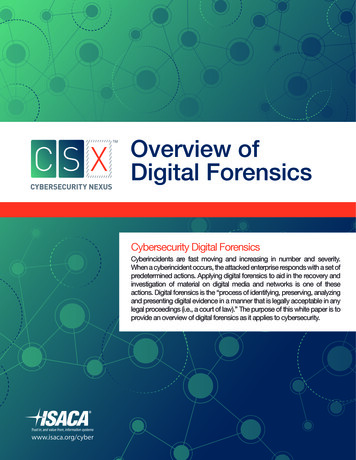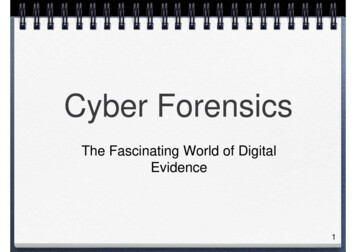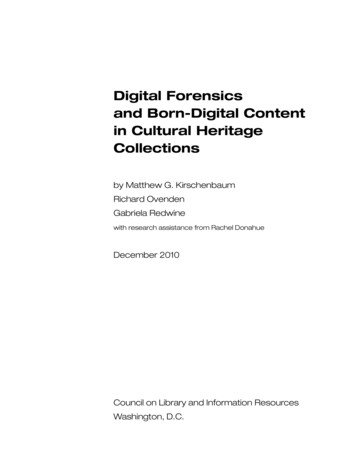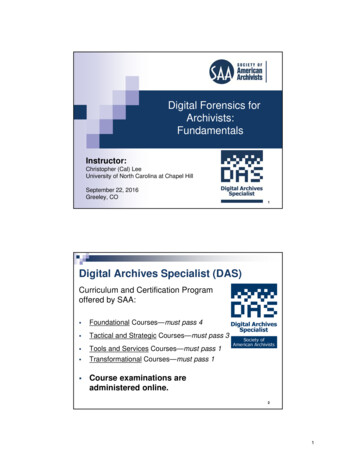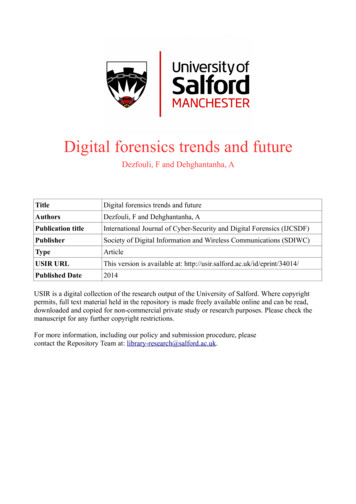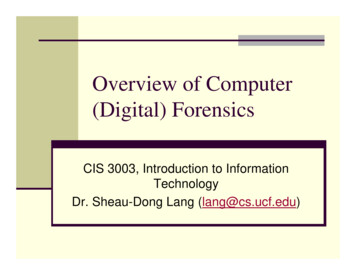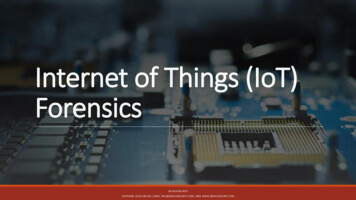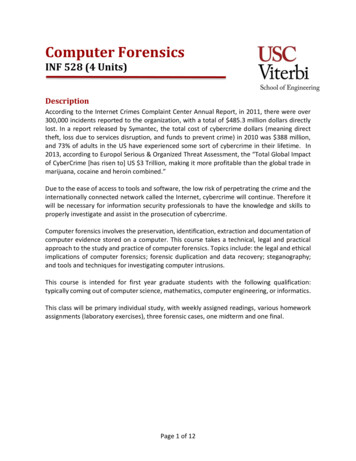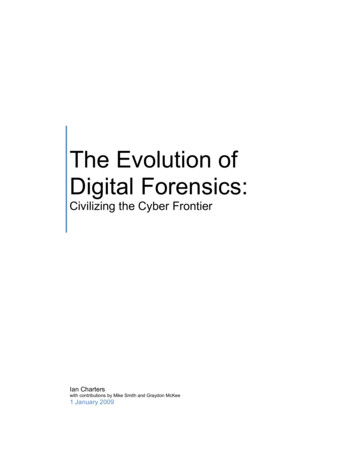
Transcription
The Basics of DigitalForensics
The Basics of DigitalForensicsThe Primer for Getting Startedin Digital ForensicsJohn SammonsTechnical EditorJonathan RajewskiAMSTERDAM BOSTON HEIDELBERG LONDONNEW YORK OXFORD PARIS SAN DIEGOSAN FRANCISCO SINGAPORE SYDNEY TOKYOSyngress is an imprint of ElsevierSYNGRESS
Acquiring Editor: Chris KatsaropoulosDevelopment Editor: Heather SchererProject Manager: Danielle S. MillerDesigner: Alisa AndreolaSyngress is an imprint of Elsevier225 Wyman Street, Waltham, MA 02451, USA 2012 Elsevier, Inc. All rights reserved.No part of this publication may be reproduced or transmitted in any form or by any means, electronic or mechanical, including photocopying,recording, or any information storage and retrieval system, without permission in writing from the publisher. Details on how to seek permission,further information about the Publisher’s permissions policies and our arrangements with organizations such as the Copyright Clearance Center andthe Copyright Licensing Agency, can be found at our website: www.elsevier.com/permissions.This book and the individual contributions contained in it are protected under copyright by the Publisher (other than as may be noted herein).NoticesKnowledge and best practice in this field are constantly changing. As new research and experience broaden our understanding, changes inresearch methods or professional practices, may become necessary.Practitioners and researchers must always rely on their own experience and knowledge in evaluating and using any information or methodsdescribed herein. In using such information or methods they should be mindful of their own safety and the safety of others, including parties forwhom they have a professional responsibility.To the fullest extent of the law, neither the Publisher nor the authors, contributors, or editors, assume any liability for any injury and/or damageto persons or property as a matter of products liability, negligence or otherwise, or from any use or operation of any methods, products,instructions, or ideas contained in the material herein.Library of Congress Cataloging-in-Publication DataSammons, John.The basics of digital forensics : the primer for getting started in digital forensics / John Sammons.p. cm.ISBN 978-1-59749-661-21. Computer crimes–Investigation. I. Title.HV8079.C65S35 2012363.25'968–dc232011047052British Library Cataloguing-in-Publication DataA catalogue record for this book is available from the British Library.For information on all Syngress publicationsvisit our website at: www.syngress.comTypeset by: diacriTech, Chennai, IndiaPrinted in the United States of America12 13 14 15 10 9 8 7 6 5 4 3 2 1
DedicationvFor Lora, Abby, and Rae for making me a trulyblessed and lucky man.To my mother Juanita, and my grandmother Grace.For the many sacrifices you made andthe example you set I miss you.
ContentsviiPREFACE . xvACKNOWLEDGMENTS . xixABOUT THE AUTHOR . xxiABOUT THE TECHNICAL EDITOR . xxiiiCHAPTER 1 Introduction . 1Introduction . 1What Is Forensic Science? . 2What Is Digital Forensics? . 2Uses of Digital Forensics . 3Criminal Investigations . 3Civil Litigation . 4Intelligence . 5Administrative Matters . 6Locard’s Exchange Principle . 7Scientific Method . 7Organizations of Note . 7Scientific Working Group on Digital Evidence . 8American Academy of Forensic Sciences . 8American Society of Crime Laboratory Directors/Laboratory Accreditation Board . 9National Institute of Standards and Technology (NIST) . 9American Society for Testing and Materials (ASTM) . 9Role of the Forensic Examiner in the Judicial System . 10The CSI Effect . 10Summary . 10References . 11CHAPTER 2 Key Technical Concepts . 13Introduction . 13Bits, Bytes, and Numbering Schemes . 13Hexadecimal . 14Binary to Text: ASCII and Unicode . 14
viiiContentsFile Extensions and File Signatures . 15Storage and Memory . 16Magnetic Disks . 17Flash Memory . 18Optical Storage . 18Volatile versus Nonvolatile Memory . 18Computing Environments . 19Cloud Computing . 19Data Types . 20Active Data . 20Latent Data . 21Archival Data . 21File Systems . 21Allocated and Unallocated Space . 22Data Persistence . 22How Magnetic Hard Drives Store Data . 23Page File (or Swap Space) . 25Basic Computer Function—Putting it All Together . 26Summary . 27References . 27CHAPTER 3 Labs and Tools . 29Introduction . 29Forensic Laboratories . 29Virtual Labs . 30Lab Security . 30Evidence Storage . 31Policies and Procedures . 32Quality Assurance . 32Tool Validation . 33Documentation . 34Digital Forensic Tools . 35Tool Selection . 36Hardware . 36Software . 39Accreditation . 40Accreditation versus Certification . 42Summary . 43References . 43
ContentsCHAPTER 4 Collecting Evidence . 45Introduction . 45Crime Scenes and Collecting Evidence . 46Removable Media . 46Cell Phones . 47Order of Volatility . 49Documenting the Scene . 49Photography . 50Notes . 51Chain of Custody . 52Marking Evidence . 52Cloning . 52Purpose of Cloning . 54The Cloning Process . 54Forensically Clean Media . 55Forensic Image Formats . 55Risks and Challenges . 55Value in eDiscovery . 56Live System versus Dead System . 56Live Acquisition Concerns . 56Advantage of Live Collection . 57Principles of Live Collection . 58Conducting and Documenting a Live Collection . 58Hashing . 59Types of Hashing Algorithms . 59Hashing Example . 59Uses of Hashing . 60Final Report . 61Summary . 61References . 62CHAPTER 5 Windows System Artifacts . 65Introduction . 65Deleted Data . 66Hibernation File (Hiberfile.sys) . 66Sleep . 67Hibernation . 67Hybrid Sleep . 67Registry . 67Registry Structure . 68ix
xContentsAttribution . 69External Drives . 70Print Spooling . 70Recycle Bin . 70Metadata . 72Removing Metadata . 74Thumbnail Cache . 75Most Recently Used (MRU) . 76Restore Points and Shadow Copy . 76Restore Points . 76Shadow Copies . 77Prefetch . 78Link Files . 78Installed Programs . 79Summary . 79References . 80CHAPTER 6 Antiforensics . 81Introduction . 81Hiding Data . 83Encryption . 83What Is Encryption? . 83Early Encryption . 84Algorithms . 85Key Space . 86Some Common Types of Encryption . 86Breaking Passwords . 88Password Attacks . 89Brute Force Attacks . 89Password Reset . 90Dictionary Attack . 90Steganography . 92Data Destruction . 94Drive Wiping . 94Summary . 100References . 100CHAPTER 7 Legal . 103Introduction . 103The Fourth Amendment . 104
ContentsCriminal Law—Searches without a Warrant . 104Reasonable Expectation of Privacy . 104Private Searches . 105E-mail . 105The Electronic Communications Privacy Act (ECPA) . 105Exceptions to the Search Warrant Requirement . 105Searching with a Warrant . 108Seize the Hardware or Just the Information? . 109Particularity . 109Establishing Need for Off-Site Analysis . 109Stored Communications Act . 110Electronic Discovery (eDiscovery) . 111Duty to Preserve . 111Private Searches in the Workplace . 112Expert Testimony . 113Summary . 114References . 115CHAPTER 8 Internet and E-Mail . 117Introduction . 117Internet Overview . 117Peer-to-Peer (P2P) . 119The INDEX.DAT File . 120Web Browsers—Internet Explorer . 120Cookies . 120Temporary Internet Files, a.k.a. web Cache . 121Internet History . 122Internet Explorer Artifacts in the Registry . 123Chat Clients . 124Internet Relay Chat (IRC) . 125ICQ “I Seek You” . 125E-Mail . 126Accessing E-mail . 126E-mail Protocols . 126E-mail as Evidence . 126E-mail—Covering the Trail . 127Tracing E-mail . 127Reading E-mail Headers . 128Social Networking Sites . 129Summary . 129References . 130xi
xiiContentsCHAPTER 9 Network Forensics . 131Introduction . 131Social Engineering . 132Network Fundamentals . 132Network Types . 133Network Security Tools . 135Network Attacks . 135Incident Response . 137Network Evidence and Investigations . 139Network Investigation Challenges . 141Summary . 141References . 142CHAPTER 10 Mobile Device Forensics . 145Introduction . 145Cellular Networks . 146Cellular Network Components . 147Types of Cellular Networks . 148Operating Systems . 149Cell Phone Evidence . 150Call Detail Records . 151Collecting and Handling Cell Phone Evidence . 152Subscriber Identity Modules . 154Cell Phone Acquisition: Physical and Logical . 155Cell Phone Forensic Tools . 155Global Positioning Systems (GPS) . 157Summary . 161References . 161CHAPTER 11 Looking Ahead: Challenges and Concerns . 163Introduction . 163Standards and Controls . 164Cloud Forensics (Finding/Identifying PotentialEvidence Stored in the Cloud) . 165What Is Cloud Computing? . 165The Benefits of the Cloud . 166Cloud Forensics and Legal Concerns . 166Solid State Drives (SSD) . 167How Solid State Drives Store Data . 167The Problem: Taking out the Trash . 168
ContentsSpeed of Change . 169Summary . 170References . 171INDEX . 173xiii
PrefacexvSeal Team Six tore the hard drives from Osama bin Laden’s computers. Some ofMichael Jackson’s final words were captured on an iPhone. Google searches forchloroform played a central role in the trial of Casey Anthony. This list could goon and on. Digital forensics is used to keep us safe, to ensure justice is doneand company and taxpayer resources aren’t abused. This book is your first stepinto the world of digital forensics. Welcome!Digital forensics is used in a number of arenas, not just in catching identitythieves and Internet predators. For example, it’s being used on the battlefieldsof Afghanistan to gather intelligence. The rapid exploitation of informationpulled from cell phones and other devices is helping our troops identify andeliminate terrorists and insurgents.It’s being used in the multibillion-dollar world of civil litigation. Gone are thedays when opposing parties exchanged boxes of paper memos, letters, andreports as part of the litigation process. Today, those documents are writtenin 1s and 0s rather than ink. They are stored on hard drives and backup tapesrather than in filing cabinets.Digital forensics helps combat the massive surge in cybercrime. Identity thieves,child pornographers, and “old school” criminals are all using and leveragingtechnology to facilitate their illegal activities.Finally, it’s being used in the workplace to help protect both companies andgovernment entities from the misuse of their computer systems.INTENDED AUDIENCEAs the title suggests, this is a beginner’s book. The only assumption is that youhave a fundamental understanding or familiarity of computers and other digitaldevices. If you have a moderate or advanced understanding of digital forensics,this book may not be for you. As part of Syngress’s “Basics” series, I wrote this bookmore as a broad introduction to the subject rather than an all-encompassing tome.I’ve tried to use as much “plain English” as possible, making it (hopefully) aneasier read.I’d like to emphasize that this is an introductory book that is deliberatelylimited in length. Given that, there is much that couldn’t be covered in depthor even covered at all. Each chapter could be a book all by itself. There are manywonderful books out there that can help further your understanding. I sincerelyhope you don’t stop here.
xviPrefaceORGANIZATION OF THIS BOOKThe book is organized in a fairly straightforward way. Each chapter covers aspecific type of technology and begins with a basic explanation of the technologyinvolved. This is a necessity in order to really understand the forensic materialthat follows.To help reinforce the material, the book also contains stories from the field,case examples, and Q and A with a cryptanalyst as well as a specialist in cellphone forensics.Chapter 1 – IntroductionWhat exactly is digital forensics? Chapter 1 seeks to define digital forensics andexamine how it’s being used. From the battlefield to the boardroom to thecourtroom, digital forensics is playing a bigger and bigger role.Chapter 2 – Key Technical ConceptsUnderstanding how computers create and store digital information is a perquisitefor the study of digital forensics. It is this understanding that enables us to answerquestions like “How was that artifact created?” and “Was that generated by thecomputer itself, or was it a result of some user action?” We’ll look at binary,how data are stored, storage media, and more.Chapter 3 – Labs and ToolsIn “Labs and Tools,” we look at the digital forensic environment and hardwareand software that are used on a regular basis. We will also examine standardsused to accredit labs and validate tools. Those standards are explored alongwith quality assurance, which is the bedrock of any forensic operation. Qualityassurance seeks to ensure that results generated by the forensic examination areaccurate.Chapter 4 – Collecting EvidenceHow the digital evidence is handled will play a major role in getting that evidenceadmitted into court. Chapter 4 covers fundamental forensically sound practicesthat you can use to collect the evidence and establish a chain of custody.Chapter 5 – Windows System ArtifactsThe overwhelming odds are that you have a Windows-based computer on yourdesk, in your briefcase, or both. It’s a Windows world. (No disrespect, Mac people. I’m one of you.) With over a 90% market share, it clearly represents the bulkof our work. Chapter 5 looks at many of the common Windows artifacts andhow they are created.
PrefaceChapter 6 – AntiforensicsThe word is out. Digital forensics is not the secret it once was. Recovering digitalevidence, deleted files, and the like is now common place. It’s regularly seen onsuch shows as NCIS and CSI. The response has been significant. They are nowmany tools and techniques out there that are used to hide or destroy data.These are examined in Chapter 6.Chapter 7 – LegalAlthough a “forensic” science, the legal aspects of digital forensics can’t bedivorced from the technical. In all but certain military/intelligence applications,the legal authority to search is a perquisite for a digital forensics examination.Chapter 7 examines the Fourth Amendment, as well as reasonable expectationsof privacy, private searches, searching with and without a warrant, and theStored Communications Act.Chapter 8 – Internet and E-MailSocial networks, e-mail, chat logs, and Internet history represent some of thebest evidence we can find on a computer. How does this technology work?Where is this evidence located? These are just a few of the questions we’llanswer in Chapter 8.Chapter 9 – Network ForensicsWe can find a network almost anywhere, from small home networks to hugecorporate ones. Like computers and cell phones, we must first understandhow things work. To that end, Chapter 9 begins with networking basics. Next,we start looking at how networks are attacked and what role digital forensicsplays in not only the response, but how perpetrators can be traced.Chapter 10 – Mobile Device ForensicsSmall-scale mobile devices such as cell phones and GPS units are everywhere.These devices are in many respects pocket computers. They have a huge potential to store evidence. Digital forensics must be as proficient with these devicesas they are desktop computers. We’ll look at the underlying technology powering cell phones and GPS units as well as the potential evidence they couldcontain.Chapter 11 – Looking Ahead: Challenges and ConcernsThere are two “game-changing” technologies that are upon us that will have ahuge impact on not only the technical aspect of digital forensics but the legalpiece as well. The technology driving solid state hard drives negates much ofthe traditional “bread and butter” of digital forensics. That is our ability torecover deleted data. As of today, there is no answer to this problem.xvii
xviiiPrefaceCloud computing creates another major hurdle. In the cloud, data are stored in acomplex virtual environment that could physically be located anywhere in theworld. This creates two problems; from a technical standpoint, there is an alarming lack of forensic tools that work in this environment. Deleted files are alsonearly impossible to recover. Legally, it’s a nightmare. With data potentiallybeing scattered across the globe, the legal procedures and standards vary wildly.Although steps are being taken to mitigate this legal dilemma, the situation stillpersists today.Being in its infancy, the digital forensics community still has work to do regardinghow it conducts its business, especially in relation to the other more traditionaldisciplines. Chapter 11 will explore this issue.
AcknowledgmentsxixAlthough my name may be on the cover, this book would not have beenpossible without the help and support of many people. First, I’d like to thankmy family, particularly my wife Lora, and my two girls, Abby and Rae. Theirpatience, understanding, and willingness to “pick up my slack” while I wrotewas invaluable. Thank you, ladies.Next I’d like to thank Nick Drehel, Rob Attoe, Lt. Lannie Hilboldt, Chris Vance,and Nephi Allred for sharing their expertise and experiences. I have no doubttheir contributions made this a better book.My Chair, Dr. Mike Little, and my Dean, Dr. Charles Somerville, also helped makethis book a reality. It would have been impossible for me to write this book andstill do my “day job” without their support and assistance. Thank you, gentlemen.I’d like to thank my Editor, Heather Scherer, and my Tech Edito
What exactly is digital forensics? Chapter 1 seeks to define digital forensics and examine how it’s being used. From the battlefield to the boardroom to the courtroom, digital forensics is playing a bigger and bigger role. Chapter 2 – Key Technical Concepts Understanding how computers create and store
